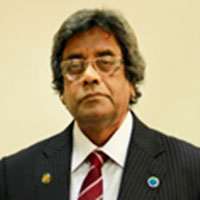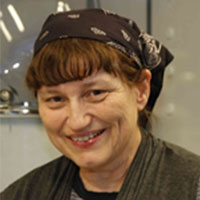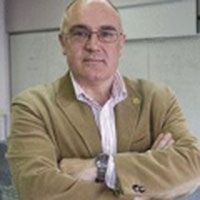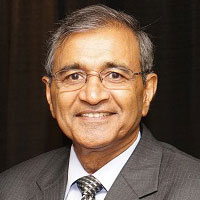National Committee

Giovanni Camino
Politecnico di TorinoItaly

Maria Rosaria Acocella
Universita di Salerno, Italy
Ilaria Fratoddi
University Sapienza of Rome, ItalyInternational Committee

Mubarak Ahmad Khan
Atomic Energy Res. EstablishmentBangladesh.
Prof. Dr. Mubarak Ahmad Khan
Chief Scientific Officer and Director General of Atomic Energy Research Establishment, Bangladesh.Dr. Mubarak Ahmad Khan is former Chief Scientific Officer (CSO) and Director General of Atomic Energy Research Establishment, Bangladesh Atomic Energy Commission. He is now working as Scientific Advisor of Bangladesh Jute Mills Corporation, Ministry of Textiles, and Jute. He is working in several promising areas of nanotechnology, material science, biodegradable polymers, biomedical science, applied science, etc. His focus is to develop sustainable technologies for related to the environment and human health. He worked in Germany as a German Academic Service (DAAD and AvH fellow, in Japan as JSPS and MIF Fellow, in the USA (Michigan State University) as a visiting scientist, in Australia (University of New South Wells) as an IAEA fellow. He is a part-time Professor of Dhaka University, Department of Nuclear Engineering, and visiting professor and examiner of various universities of Bangladesh. His name was published Who’s Who in the World 1998. He is also selected as a Fellow of IUPAC. He is the author/co-author of about 600 publications including 22 book chapters and four patents. He supervised more than 300 M.Sc. 8 M. Phil and 20 Ph.D. students. He has invented biodegradable polybag (Sonali Bag) from jute, advanced wound dressing material from cow bone, liquid bio-fertilizer from textile effluent, natural plant growth promoter from prawn shell, etc. He is also the inventor of Justin (Jute Reinforced Polymer Corrugated Sheet), the outstanding housing material from jute plastic composite. He received several national and international awards such as the Bangladesh Academy of Science Gold Medal (2010), National Jute Award (2017), Federation of Asian Chemical Society (2017), National Environment Gold Medal Award 2019, Pollima Green Gold Medal Award 2019, etc. for his remarkable contributions to the scientific community. At present, he is the number one scientist in the Jute sector all over the world with respect to international publications cited by Scopus. He is also selected as a Fellow of IUPAC and Bangladesh Academy of Science (BAS). He was born in Manikganj, Bangladesh on 31st January 1958.

Pieter Samyn
SIRRIS – Smart Coatings LabBelgium
Pieter Samyn
Hasselt University, Institute for Materials Research, Applied and Analytical Chemistry, Belgium.Dr. ir. Pieter Samyn received Ph.D. in Materials Science and Engineering in 2007 from Ghent University presenting his research on polymer tribology. He followed an academic career from 2000 to 2020 at the Universities of Ghent, Freiburg, Toronto, and Hasselt having different positions of assistant professor and visiting professor. In 2021, he joined the collective research centre Sirris as a Senior Researcher in Circular Economy and Renewable Materials. His experiences focus on the synthesis, processing, and characterization of bio-based materials for composites and coatings. He led research projects on bio-inspired adhesion mechanisms, protective coatings for papers, advanced analytics, and processing of nanocomposites from bio-based building blocks. The latter were also used for the fabrication of composites with functional interfaces and in-build sensoring properties. His work was awarded with several distinctions including the Robert-Bosch Juniorprofessorship, Baden-Wurttemberg Juniorprofessorenprogramm, and Heinz-Maier Leibnitz Preis and FRIAS Fellowship. Currently, he assists companies in the implementation of bio-based polymer coatings and paints for industrial applications.

Miriam Rafailovich
Stony Brook UniversityUnited States.
Miriam Rafailovich
Stony Brook University, United States.Miriam Rafailovich received her Ph.D. from Stony Brook University in Applied Nuclear Physics. She then did her post-doctoral work at Brookhaven National Laboratory and the Weizmann Institute. Miriam was an associate professor of Physics and Astronomy at CUNY, Queens College, and is currently a distinguished professor at Stony Brook University in the Department of Materials Science and Engineering. Miriam is the director of the Garcia Center for Polymers at Engineered Interfaces. Her research interests span a broad spectrum which includes, Polymer nanocomposites for additive manufacturing, biopolymers, biosensors, tissue engineering scaffolds, nanotoxicology, flame retardant composites, and polymers for green energy applications. Miriam is also known as a pioneer in the integration of research with education. She has graduated more than 60 Ph.D. and Masters's students and mentored several hundred undergraduate and high school students from across the United States and abroad. She is the co-author of more than 400 publications in peer-reviewed journals and technical review articles, a Lady Davis Foundation Scholar, and a fellow the American Physical Society.

Pedro Martinho
Polytechnic Institute of LeiriaPortugal
Pedro Martinho
Polytechnic Institute of Leiria, Portugal.Professor/Researcher of the Polytechnic Institute of Leiria, Portugal. He graduated in Mechanical Engineering at the University of Coimbra, received his MSc in Molds Design and Manufacturing, and Ph.D. in Science and Engineering with Polymers and Composites, both from the University of Minho, Portugal. He teaches several subjects related to polymers and composites materials, rapid prototyping, and tooling technologies. He has several publications in conference proceedings, book chapters, and journals, related to polymers, molds design, and manufacturing for plastic parts. He is a member of the Institute of Nanostructures, Nanomodeling and Nanofabrication, and of the Center for Rapid and Sustainable Product Development.

Manuel Jose Lis Arias
Polytechnic University of Catalonia, SpainManuel Jose Lis Arias
Polytechnic University of Catalonia, SpainManuel José Lis Arias. Degree Projects, both in Technical Engineering and Industrial Engineering, Undergraduate Projects, and Master's Final Projects. Said works have been related to its field of Chemical Engineering, as well as in subjects related to Textile and Materials. He has taught and coordinated nine different subjects, all of them within the Chemical Engineering degree, and has collaborated in the Master of Biotechnological Engineering and in the Textile Engineering Master. He has held various academic positions, such as Deputy Director of Studies at EUETIT, Deputy Director of International Relations EUETIT, Deputy Director INTEXTER, Deputy Delegate of the Rector of the Terrassa Campus, Head of the Textile and Paper Department by Delegation of the Rector and Deputy Director of the Department of Chemical Engineering, all of them at the UPC. Since he began his activities in INTEXTER, he has participated in the preparation of studies related to companies from which more than 1000 technical reports are derived. In the field of research, he has participated in six competitive projects, funded by the Ministry of Education and Research, and has developed more than 20 research plans with private companies and public entities as coordinator. He has published more than 100 research articles in national and international journals, of which more than half have been published in JCR indexed journals. He has published four books and has more than 10 book chapters. He has presented more than 90 papers in Congresses, national and international. In three of them, he has received prizes and awards, linked to the level of the conferences and topics covered. He is a member of the American Oil Chemistry Association (USA) and The Textile Institute (UK), as well as member of the Board of Directors of the Spanish Association of Textile Chemists and Colourists. He has been named as Honorary Member of the Latin American Association of Textile Chemists and Colourists for more than 20 years. His fields of research have always been developed around materials and transport phenomena involved in chemical functionalization on material systems. In the last 15 years, basically dedicated to the obtaining, evaluation, and application of micro and nano encapsulated systems. Both active principles for cosmetic/pharmaceutical use in textile systems, and in the development of microstructured systems for biomedical applications. Member of seven Editorial Board of international journals and reviewer of articles from more than 20 research journals.

Bharat Bhushan
The Ohio State UniversityUSA
Bharat Bhushan
The Ohio State UniversityUSA
Dr. Bharat Bhushan received an M.S. in mechanical engineering from the Massachusetts Institute of Technology in 1971, an M.S. in mechanics and a Ph.D. in mechanical engineering from the University of Colorado at Boulder in 1973 and 1976, respectively, an MBA from Rensselaer Polytechnic Institute at Troy, NY in 1980, Doctor Technicae from the University of Trondheim at Trondheim, Norway in 1990, a Doctor of Technical Sciences from the Warsaw University of Technology at Warsaw, Poland in 1996, Honorary Doctor of Science from the National Academy of Sciences, Gomel, Belarus in 2000, University of Kragujevac, Serbia in 2011, and University of Tyumen, Russia in 2019. He is a registered professional engineer. He is presently an Academy Professor (San Jose, CA), and has served as an Ohio Eminent Scholar and The Howard D. Winbigler Professor in the College of Engineering, Director of the Nanoprobe Laboratory for Bio- & Nanotechnology and Biomimetics (NLB2), and affiliated faculty in John Glenn College of Public Affairs at the Ohio State University, Columbus, Ohio. In 2013-14, he served as ASME/AAAS Science & Technology Policy Fellow, House Committee on Science, Space & Technology, United States Congress, Washington, DC. He has served as Expert Investigator on IP related issues in the U.S. and International Courts. His research interests are in Fundamental studies in the interdisciplinary areas of Bio/nanotribology/nanomechanics, Nanomaterials Characterization, Scanning Probe Techniques, Magnetic Storage, Bio/nanotechnology, Nanomanufacturing, Bioinspired Liquid Repellency, Self-cleaning, Anti-icing, Anti-fouling, and Water Harvesting, Science and Technology Policy. He is an internationally recognized expert of bio/nanotribology and bio/nanomechanics using scanning probe microscopy, and biomimetics. He is considered by some one of the pioneers of the tribology and mechanics of magnetic storage devices, nanotribology, green tribology, and biomimetics. He had introduced the word nanotribology in a title of a Nature paper in 1995 and green tribology in 2010. He is one of the most prolific authors. He has authored 10 scientific books, 100+ handbook chapters, and 900+ scientific papers (Google Scholar’s one of 1248 Highly Cited Researchers in All Fields, h-index - 140+ with 90k+ citations; Scopus’s one of 401Scientists for Career-long Citation Impact Across All Fields, and Fourth Highly Cited Researcher in Mechanical Eng., out of over 8 million scientists from around world; ISI Highly Cited Researcher in Materials Science and in Cross-field Category. His research was listed as the Top Ten Science Stories of 2015. He has also edited more than 60 books and holds more than 25 U.S. and foreign patents. He is co-editor of Springer NanoScience and Technology Series and co-editor of Microsystem Technologies. He has given more than 400 invited presentations including 300+ keynote/plenary addresses at major international conferences on six continents. He delivered a TEDx 2019 lecture on Lessons from Nature. His biography has been listed in over two dozen Who's Who books including Who's Who in the World. He has received more than two dozen awards for his contributions to science and technology from professional societies, industry, and U.S. government agencies including the International Tribology Gold Medal and Institution of Chemical Engineers (UK) Global Award for bioinspired surfaces. He received NASA’s Certificate of Appreciation to recognize the critical tasks performed in support of President Reagan’s Commission investigating the Space Shuttle Challenger Accident. He is also the recipient of various international fellowships including the Alexander von Humboldt Research Prize for Senior Scientists, Max Planck Foundation Research Award for Outstanding Foreign Scientists, and Fulbright Senior Scholar Award. He is foreign member of the International Academy of Engineering (Russia), Byelorussian Academy of Engineering and Technology and the Academy of Triboengineering of Ukraine, honorary member of the Society of Tribologists of Belarus and STLE, a fellow of ASME, IEEE, and the New York Academy of Sciences, and member of ASEE, Sigma Xi and Tau Beta Pi. He is an accomplished organizer. He organized the Ist Symposium on Tribology and Mechanics of Magnetic Storage Systems in 1984 and the Ist Int. Symposium on Advances in Information Storage Systems in 1990, both of which are now held annually. He organized two international NATO institutes in Europe. He is the founder of an ASME Information Storage and Processing Systems Division founded in 1992 and served as founding chair during 1993-1998. He has previously worked for Mechanical Technology Inc., Latham, NY; SKF Industries Inc., King of Prussia, PA; IBM, Tucson, AZ; and IBM Almaden Research Center, San Jose, CA. He has held a visiting professorship at the University of California at Berkeley, University of Cambridge, UK, Vienna University of Technology, Austria, University of Paris, Orsay, ETH Zurich, EPFL Lausanne, Univ. of Southampton, UK, Univ. of Kragujevac, Serbia, Tsinghua Univ., China, Harbin Inst., China, and KFUPM, Saudi Arabia.

Cyrille Boyer
The University of New South Wales, AustraliaCyrille Boyer
The University of New South Wales, AustraliaProf Cyrille Boyer received his PhD from the University of Montpellier II (Ecole Nationale Superieure de Chimie de Montpellier, France; awarded in 2006). His PhD was performed in collaboration with Solvay-Solexis for the preparation of new adhesives, which was tested in industrial scale. At the end of his PhD, he undertook an engineer position with Dupont Performance Elastomers, dealing with the synthesis of fluorinated elastomers. Later, he joined the University of New South Wales in the School of Chemical Engineering, where, in 2009, he was awarded an Australian Research Council Fellowship (ARC-APD). In 2011, he joined the Australian Centre for Nanomedicine as a project leader to develop new polymeric nanoparticles for drug delivery and gene therapy. In 2012, Cyrille has been awarded an Australian Research Council - Future Fellowship. In 2016 (starting in January 2017), Cyrille has been promoted as full Professor at the University of New South Wales and co-Director of Australian Centre for Nanomedicine. Cyrille’s research interests mainly cover the preparation of functional macromolecules, where he developed new polymerization techniques using photocatalysts. These macromolecules find applications in various areas, including in nanomedicine for the delivery of therapeutic molecules and imaging agents as well as in energy storage. Cyrille has published over 275 research articles and 5 international patents, patented by several companies, including Dupont Performance Elastomers, Toso Company, etc. His research has been recognized by several research awards, including 2016 ACS Biomacromolecules/Macromolecules Young Researcher Awards, 2016 Journal of Polymer Science Innovation Award, Le Fevre Memorial Prize for Chemistry; 2015 Malcolm McIntosh Prize for Physical Science (one of the six Prime Minister Prize), 2013 Scopus Research Award and in 2016/2015 Finalist of Eureka Research Excellence Award.
Giovanni Camino
Politecnico di TorinoItaly
Giovanni CAMINO Born on May 2, 1941, Torino, Italy. He did his Italian Degree of Doctor in Chemistry, July 1966. He worked in the University of Torino, Assistant, and he was a member of National Research Council from 1966-1969. 1969-1987, Associate Professor of Macromolecular Chemistry at University of Torino, 1987-2001 -Since 2001 at Politechnic of Torino, he was a Full Professor of Industrial Chemistry and Polymer Materials. His Research interests are: - Mechanisms of thermal degradation of polymers - Mechanisms of fire retardance in polymeric materials - Nanocomposites - Mechanisms of thermo and photooxidation of polymers - Recycling - Ageing mechanisms in composites - Mechanisms of polymerisation
He published 270 Chapters in books: 8 Invited lectures: 92 Communications at Conferences: 210 Guest editor of Die Makromolekulare Chemie, Macromol. Symp., Vol. 74, Fire Retardant Polymers Co-Editor of “Fire Retardancy of Polymers: The Use of Intumescence”, The Roy. Soc. Chem:, 1998 External activities -Chairman of the Italian Macromolecular Group 1995-1997 -Member of Editorial Board of: - "Polymer Degradation and Stability" since 1985
